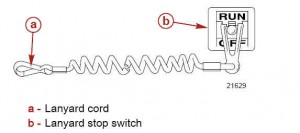Boat Lanyard Cords & Switches
How many times have you been in one of these positions?
- You go to start the engine in your boat but it won’t crank. You start looking for issues and realize nothing works, not even the stereo system. After 10-15 minutes it dawns on you to take a look at the Lanyard Kill Switch. After further observation you realize that the Kill Switch somehow got moved to the off position. You then go ahead and start the engine and your wife or buddy asks what the problem was and you say “I don’t know” it just decided to start all of a sudden”.
- Your out on the lake with the family for a weekend of taking it easy and pulling the kids on the tube. You hop into the drivers seat, crank the engine and take off with the Lanyard Kill Switch Cord dangling in the wind.
- Your out on the lake on a 15F morning to go waterfowl hunting. You get seated in your Jon Boat that’s equipped with a Tiller Handle operated outboard motor. Before even starting the engine you make sure to wrap the Lanyard Kill Switch Cord around your wrist.
The lanyard cord is usually between 4-5 feet in length when fully stretched out. One end of the cord includes a snap which is intended to be attached directly to the boat operator or you can also make a loop that your wrist can be slipped through. The other end of the cord includes an element that is intended to be inserted into the toggle kill switch. At rest the lanyard cord is coiled so that it remains as short as possible which then reduces the opportunity for it to get tangled up with other objects inside the boat cockpit area. The length of the lanyard cord is designed to be long enough so the operator can move around the operators area without inadvertently disconnecting the cord and stopping the engine.
Important Safety Information: The lanyard stop switches main purpose occurs if the operator moves far enough away from the operators position or falls overboard in which case it will stop the engine. Being ejected from a boat or accidentally falling overboard can be more likely to happen in certain types of boats that have low sides, high speed boats, sensitive handling boats such as tiller handle controlled outboards. Being ejected or falling overboard is more likely to happen as a result of poor operating practices, unsafe handling, not being seated properly as well as certain weather conditions such as high winds. For example Tiller handle operated boats can be more susceptible to this when the single hand being used to operate the boat is released and the torque of the motor then causes the motor to turn completely to one side.
**It is important to note that simply using the lanyard stop cord/switch does not eliminate the need for proper operation of the vessel or proper seating inside of the vessel while underway.

